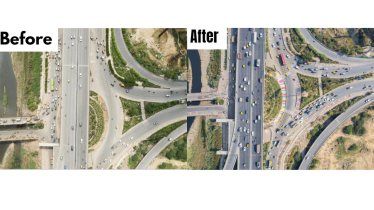New Delhi-headquartered non-profit organisation SaveLIFE Foundation, with support from Tata Power Delhi Distribution, Delhi Traffic Police, Delhi Transport Department, and PWD, has launched a ‘Tactical Urbanism’ trial at Mukundpur Chowk, an area that has witnessed 32 serious crashes between 2017 and 2021, leading to 10 deaths and 35 injuries.
What is Tactical Urbanism?
Tactical Urbanism (TU) trials are temporary, quick and relatively low-cost interventions, which test out urban design, transportation planning and infrastructural changes for improving road safety for all road users, especially the most vulnerable, like pedestrians, cyclists and other non-motorised transport users. Once the interventions are proven, the relevant Government agencies are expected to make them permanent.
As part of the Zero Fatality Corridor (ZFC) initiative, SaveLIFE Foundation tests temporary urban design interventions. An essential component of these trials is road space redistribution to ensure modal equity, road geometrics modification, traffic channelisation, vehicular speed reduction, and addition of pedestrian and cyclist safety infrastructure.
A spokesperson of Tata Power Delhi Distribution said, “Road crashes are an enormous cause of concern across the country. The loss of life and livelihood witnessed as a result of road crashes requires immediate attention and innovative solutions. Through this association with SaveLIFE Foundation to help introduce innovative interventions at Mukundpur Chowk, we are hoping to make the stretch safer for all types of road users in the long run.”
Despite the fact that the Mukundpur Chowk is a roundabout, it does not operate as one. Two existing U-turns channelise this intersection that receives heavy commuter traffic from the nearby Majlis Park Metro Station. The intersection is expected to receive more footfall in the future owing to an upcoming Delhi Metro Station.
Vijender Singh, Executive Engineer (North Maintenance Circle), Public Works Department, Government of NCT of Delhi, said, ”With an average of approximately 22,000 pedestrians and approximately 1,50,000 vehicles using the Mukundpur Chowk on a daily basis, this location experiences heavy pedestrian footfall and vehicular movement. In addition, the intersection also experiences a high level of over-speeding during non-peak hours. Goods/commercial vehicles and cars using this intersection have been seen speeding over 60 kmhr. These are few of the factors that have contributed towards the road crashes witnessed at Mukundpur Chowk.”
Major changes made as part of the initiative:
The major interventions part of the initiative at Mukundpur Chowk include traffic-calming measures such as rumble strips, and conflict zone markings positioned before turns to help alert motorists and reduce speeds. Other interventions include streamlining of vehicular flow by way of geometric design correction using barricades and cones.
For users of public transport, the interventions include introduction of dedicated Bus Stops and Intermediate Public Transport stands near the intersection for easy and safer boarding and alighting.
To improve the safety of pedestrians and cyclists, pedestrian crossing distance and exposure lengths were reduced by provision of dedicated shortest pathways to cross the intersection.
Other measures include a protected continuous pedestrian realm, extended shared space and safe pedestrian crossings as well as installation of wayfinding signages. The month-long trial will end on December 17.
Piyush Tewari, CEO, SaveLIFE Foundation said, “The Tactical Urbanism trials undertaken by SLF within its Zero Fatality Corridor programme use data, evidence and design thinking to determine the best possible solutions to save lives.”
This redesigning at Mukundpur Chowk has led to a 72 percent reduction in the pedestrian exposure distance and a 121% increase in space available for pedestrians. This is the sixth Tactical Urbanism trial in New Delhi, with the five previous ones conducted at Bhalswa Chowk, Rajghat Intersection, Gandhi Vihar, Burari Chowk and the Signature Bridge.
